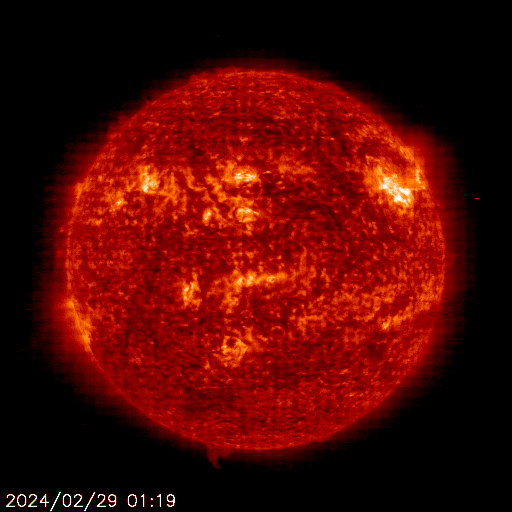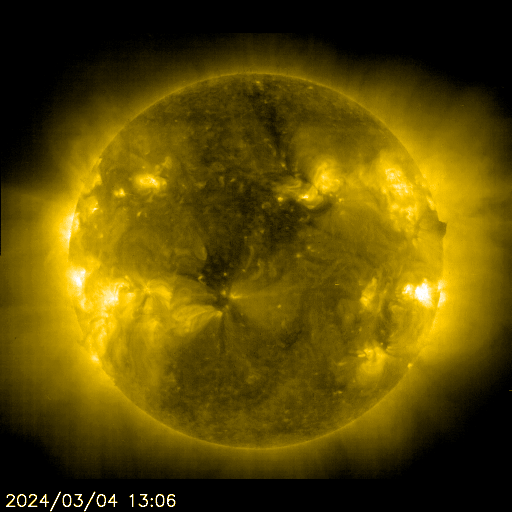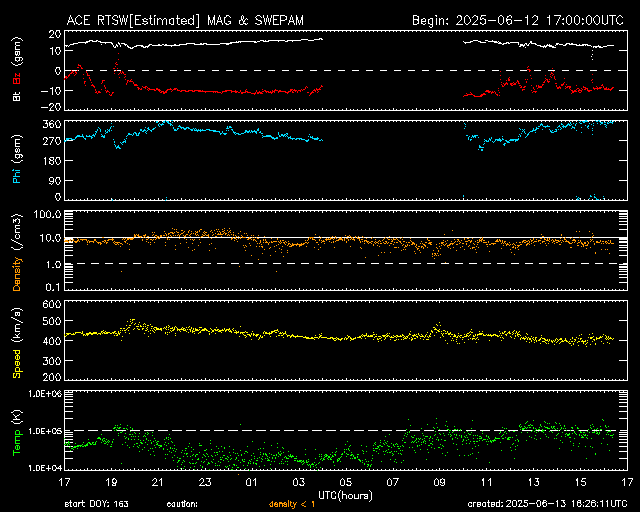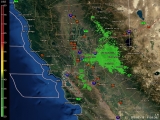Real Time Images of the Sun
SOHO EIT 304
|
SOHO EIT 284 Animated
|
LASCO/C2
|
The sun is constantly monitored for sun spots and coronal mass ejections. EIT (Extreme ultraviolet Imaging Telescope) images the solar atmosphere at several wavelengths, and therefore, shows solar material at different temperatures. In the images taken at 304 Angstrom the bright material is at 60,000 to 80,000 degrees Kelvin. In those taken at 171 Angstrom, at 1 million degrees. 195 Angstrom images correspond to about 1.5 million Kelvin, 284 Angstrom to 2 million degrees. The hotter the temperature, the higher you look in the solar atmosphere.
Solar activity reached very high levels. Region 3663 (N26W70, Fkc/beta-gamma) exhibited signs of decay as it approached the western limb, and appears to be losing its delta configuration. However, this region continued to produce multiple M-class flares, as well as an X1.0 flare early in the period at 08/0141 UTC, and another X1 flare that peaked at 08/2140 UTC. Region 3664 (S19W24, Fkc/beta-gamma-delta) continued to grow and evolve, eventually merging with Region 3668 (S15W13). This new combined spot group will maintain the 3664 region designation, and is now over 1,760 millionths in size. This region was responsible for an X1.0 flare at 08/0509 UTC. The X flare was accompanied by Type II and IV sweeps and a 10.7 cm radio burst. A halo CME associated with this event is first visible in C2 imagery near 08/0600 UTC. Additionally, Region 3664 produced an M8.6 flare at 08/1204 UTC, with an associated CME first visible in C2 imagery at 08/1224 UTC. Modeling of the two CMEs indicated that the second CME, with an estimated speed of nearly 800 km/s, will likely overtake the first CME, which had an estimated speed 715 km/s. The arrival time of the combined CMEs is anticipated to be late on 10 May to early on 11 May. The remaining spotted active regions were stable or in gradual decay and primarily inactive. Other activity included an approximately 35° long filament that erupted, centered near E27N18, with an associated CME, mostly moving in a northeasterly direction. Analysis and modeling of this event is currently underway.
Solar Activity Forecast
Issued: 2024 May 09 0030 UTC
Solar activity is expected to persist at high to very high levels over 09-11 May, with M-class flares (R1-R2/Minor-Moderate) expected and X-class flares (R3/Strong) likely, due to the continued flare potential of Region 3663 and especially Region 3664. Energetic
Real Time Solar X-ray and Solar Wind
Solar Cycle Progression
Solar Cycle chart updated using the latest ISES predictions. |
Real-Time Solar Wind
Real-Time Solar Wind data broadcast from NASA's ACE satellite. |
The Solar Cycle is observed by counting the frequency and placement of sunspots visible on the Sun. Solar minimum occurred in December, 2008. Solar maximum is expected to occur in May, 2013.
Solar X-ray Flux This plot shows 3-days of 5-minute solar x-ray flux values measured on the SWPC primary and secondary GOES satellites. |
Satellite Environment Plot The Satellite Environment Plot combines satellite and ground-based data to provide an overview of the current geosynchronous satellite environment. |
Auroral Activity Extrapolated from NOAA POES
Northern Hemi Auroral Map
|
Southern Hemi Auroral Map
|
Instruments on board the NOAA Polar-orbiting Operational Environmental Satellite (POES) continually monitor the power flux carried by the protons and electrons that produce aurora in the atmosphere. SWPC has developed a technique that uses the power flux observations obtained during a single pass of the satellite over a polar region (which takes about 25 minutes) to estimate the total power deposited in an entire polar region by these auroral particles. The power input estimate is converted to an auroral activity index that ranges from 1 to 10.
Credits:
Space Weather Images and Information (excluded from copyright) courtesy of: NOAA / NWS Space Weather Prediction Center, Mauna Loa Solar Observatory (HAO/NCAR), and SOHO (ESA & NASA).Space Weather links:
3-Day Forecast of Solar and Geophysical Activity
Space Weather Now
Real-Time Solar Wind
Solar and Heliospheric Observatory (SOHO)
The Very Latest SOHO Images





